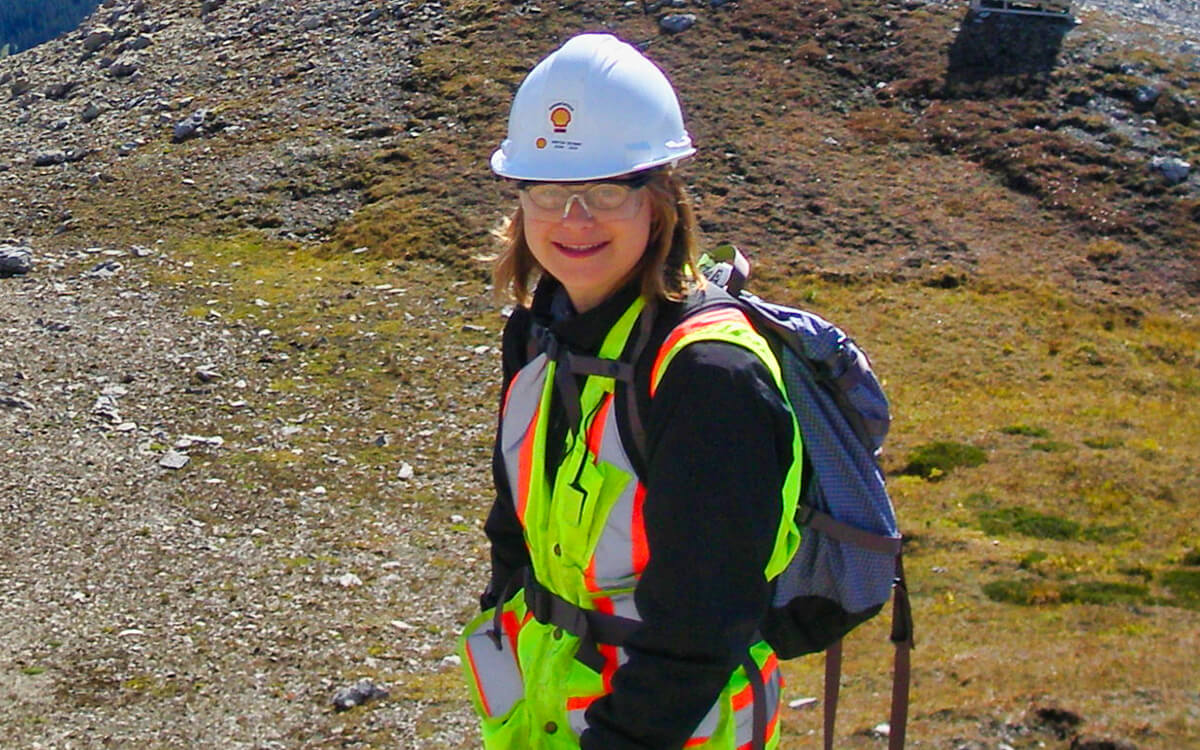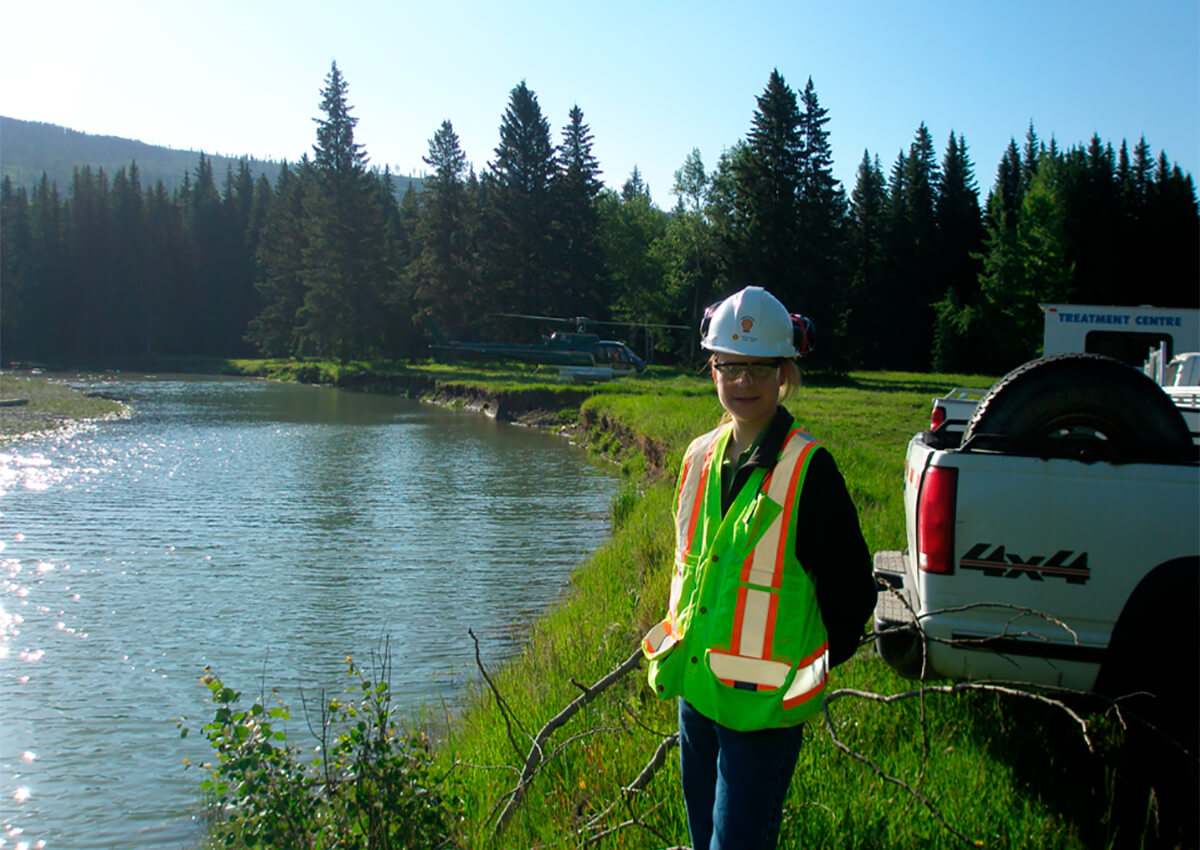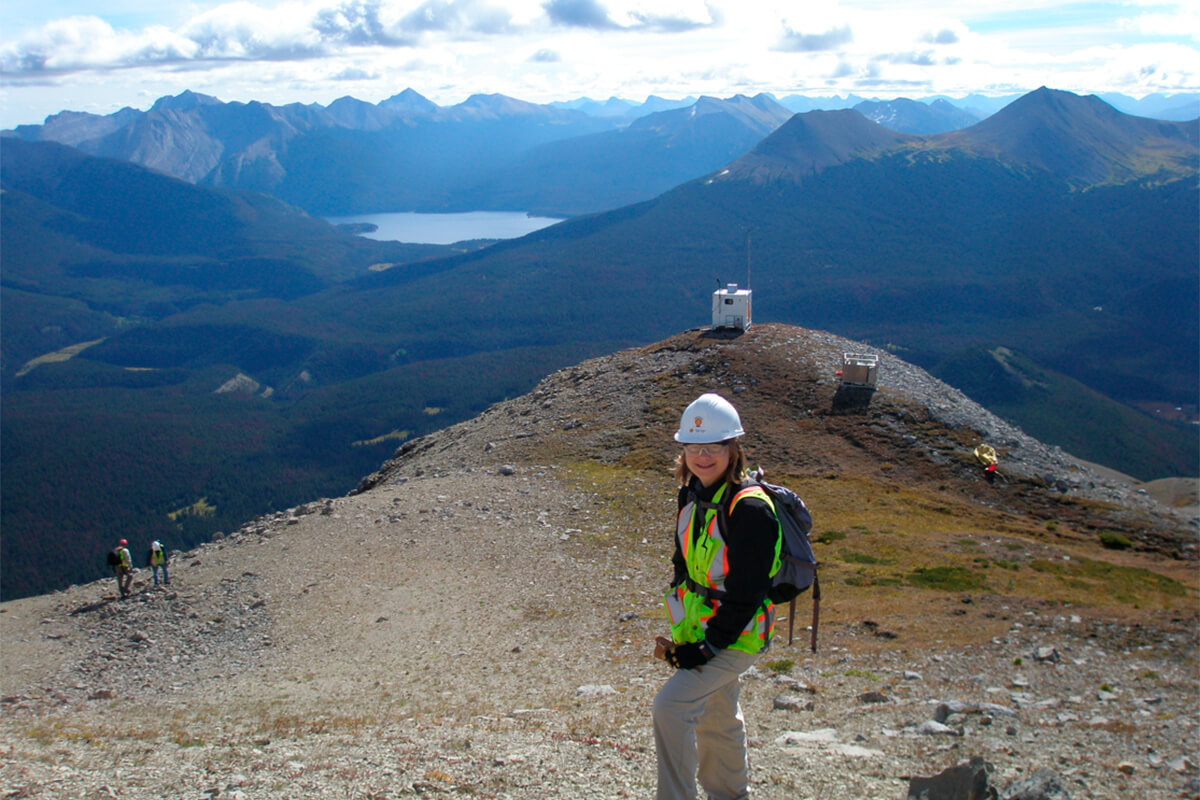
Andrea Crook has worked for an oil company, a geophysical consulting company, both in Calgary, and is now the President of OptiSeis Solutions Ltd., a geophysical acquisition software and survey design company focused on developing innovative acquisition solutions for acquiring high resolution seismic data. She likes to share her seismic acquisition knowledge by way of courses that she conducts on the CSEG and SEG platforms. She is a Professional Geophysicist (P. Geoph.) registered with APEGA, and a member of many other professional societies. Besides her technical expertise, Andrea is an experienced piano teacher registered with the R.C.M. (Royal Conservatory of Music).
Andrea very sportingly agreed to my request for an interview, from which the following are some excerpts

Andrea, how did you get to pursue a career in geophysics?
I have always loved math and science, so I began my university career with a joint degree in Math and Physics. However, as I started thinking about a career to pursue, I realized I wanted to work in applied sciences. While researching possible jobs, I came across the term geophysics, which appeared to combine geology with physics. Growing up in Manitoba, I had never heard about geophysics, but was familiar with geology, so I met with the head of the geophysics department, Ian Ferguson, at the University of Manitoba. He described some of the research they were currently doing on isostatic rebound in Churchill, Manitoba. It sounded fascinating and I had always had an interest in rocks (I still have my rock collection from when I was 4 years old), so I transferred into the University of Manitoba’s Science program and studied hard rock geophysics. My intention was to work in mining, but while completing my degree, I had an opportunity to work as a summer student for PetroCanada in Calgary. The project was captivating, and I enjoyed my time in Calgary, so after graduation in 2002, I accepted a job offer with Shell Canada and moved to Calgary.
You have been associated with seismic data processing as well as acquisition, but eventually settled down with a company that is involved with the latter. Please talk to us about this preference.
As a seismic processor at Shell Canada, I found that many of the problems I encountered in processing were directly related to the seismic acquisition. This varied from problems with near surface conditions, changes during field operations, or even errors in the documentation of the seismic program. The general training path at the time was to move from processing to interpretation. However, I felt that as an interpreter, I would now be dealing with both the problems that may have occurred in seismic acquisition as well as related uncertainties in the processing. What I really wanted to do was solve these problems, so I chose to move into seismic acquisition to ensure that the data was acquired correctly from the beginning.
I see that you left Shell Canada in 2008 and joined a consulting company. What led to that decision?
Working for Shell Canada was a wonderful experience, but at the time, the company was beginning to reduce the amount of seismic acquisition they were doing and, overall, oil and gas exploration in Canada was decreasing. As much as I enjoyed working for Shell, I was most interested in designing and acquiring multiple seismic surveys per year. I considered relocating to a subsidiary conducting more seismic acquisition, but ultimately decided to stay in Canada and pursue opportunities at Boyd PetroSearch, where I was able to work on numerous seismic acquisition projects. This turned out to be a wise decision, since although oil and gas seismic acquisition in Canada was declining, seismic acquisition for Potash exploration, which was a specialty of Boyd PetroSearch, was increasing.
How did you decide to start OptiSeis Solutions Ltd. and what is your current role there?
As a consultant, I was beginning to get requests for more detailed acquisition design analysis and realized that there was a need for an independent seismic design specialist in Calgary. This was also observed by two other acquisition design specialists, and we decided to combine our skills and start a company offering these services. Since then, OptiSeis has grown into an international seismic acquisition software and consulting company with an active research division specifically focus on reducing the environmental impact of land seismic surveys.

When we first started the company, my role as the Chief Geophysicist was primarily technical, and I was responsible for designing and acquiring both Canadian and international seismic exploration programs. As the company grew, I moved into the role of President, and now I oversee a team of both software and geophysical employees and consultants. However, I am still actively involved in designing seismic programs, and I also teach seismic acquisition courses on a regular basis.
What would you say are the challenges of becoming an entrepreneur?
Being an entrepreneur requires flexibility since you will wear many hats: geophysicist, marketer, accountant, IT specialist. As an employee or even contract consultant, your focus is on the technical work, but as a business owner, particularly one with employees working for you, your job description expands exponentially. It is important to ensure your team has diverse skillsets and for you to know when to outsource key skills. For example, our company has been structured with everyone working from home from the day we started the company. We have an external IT contractor who manages our connectivity and IT infrastructure. This has enabled us to focus on our projects rather than worrying about data transfers and maintaining connectivity.
What personal trait do you think helped you become a successful entrepreneur, and stay in geophysics for as long as you have, and how has your career shaped up so far?
As mentioned previously, I think one of the key traits is flexibility. This combined with a willingness to embrace new technologies, and a curiosity about how to improve data quality have all kept me motivated to keep learning and growing in my career. Having the opportunities to work with clients and colleagues that are similarly motivated has made the technical work throughout my career very satisfying.
In addition, I am grateful for the opportunities to give back and share my knowledge through publications, presentations, and teaching courses - both here in Canada with the Doodletrain, and internationally through the SEG. I look forward to many more years of productive work in the geophysical industry and am excited to see what new innovations may be available in the near future
If low frequencies are recorded in seismic data (land or marine), they can prove to be useful in several ways – providing a sharper wavelet, helping improve velocity analysis carried out on prestack data, enabling the imaging of higher frequencies, and producing images of the subsurface that are more interpretable than images produced without them (subsalt and subbasalt). Impedance inversion carried out on such data proves to be especially useful. From a practical standpoint, what can be done to acquire these low frequencies? Are there specific types of sources and receivers that can be used for recording such low frequencies? And, if seismic data with frequencies down to 1.5 or 2 Hz can be acquired in the field satisfactorily, full-waveform inversion can be used to generate an accurate velocity model for absolute impedance inversion. Do you think we are headed there?
This is an active area of research and progress is being made in several areas including in survey geometry and recording equipment.
Firstly, the low frequencies need to be generated. This can be a challenge when using a Vibroseis source or a small explosive source. With Vibroseis, we can utilize shaped sweeps to emphasize both high and low frequencies. However, this can be challenging due to limitations within the hydraulic system and the overall weight of the Vibroseis. Larger Vibroseis will have an easier time generating low frequencies, but due to hydraulic constraints, will only be able to operate a low force. Smaller Vibroseis may lack the weight necessary to generate these frequencies. However, advances in vibe electronics to better control the hydraulics, new full force electronic Vibroseis designs, and shaped, low dwell sweeps can be utilized to acquire these frequencies. I have worked on programs where we have successfully started the Vibroseis sweep at 1.5 Hz.
Secondly, these low frequencies must be recorded, and this is where geophone technology plays an important role. Over time, the resonant frequency of the analogue geophone has been decreasing. In Canada, older seismic programs utilized geophones with a 14 Hz resonance frequency. We typically now record data with 10 Hz geophones, but there has been significant development in low frequency geophones with 5 Hz, 4 Hz, or 2 Hz resonance frequency. There are some challenges here as well. With lower resonance frequency, the size and weight of the geophone increases. High fidelity, ultra-low frequency geophones are actively used in earthquake seismology but are too large and heavy for a typical seismic exploration survey. However, there are 5 Hz geophones utilized on seismic surveys. Both 10 Hz, 5 Hz, and digital geophones are capable of recording frequencies below 5 Hz, and processing techniques, such as applying the geophone response curve can also be used to recover the low frequencies.
Finally, since the low frequency energy is often several decibels lower than the rest of the signal, these frequencies may need to be amplified. This can be accomplished through the use higher trace density geometries, which will improve signal-to-noise ratio and careful processing to remove noise and preserve signal. Although we currently still have a gap between the frequencies needed for full wave-form inversion and what can be acquired with a standard seismic survey, advances in acquisition technology coupled with cost-effective high trace density surveys (millions to hundreds of millions of traces per square km) are getting us closer to this goal.
More recently, I noticed that you have advocated for transitioning from explosive source seismic acquisition to high-density Vibroseis acquisition. Would you please elaborate?
The reason for this is that it is often more cost-effective to acquire high density surveys with a Vibroseis source since cost per source is significantly less than traditional explosive sources. However, new advances in alternative sources, such as those showcased at the COSIA (Canada’s Oil Sands Innovation Alliance) workshop in November 2020, could also help in achieving high trace density at an affordable cost. One thing to keep in mind is that Vibroseis and/or alternative sources are often weaker and noisier than traditional explosive sources. As a result, part of the increase in trace density is to compensate for the decreased signal-to-noise ratio on the shot records. However, the key benefit with these sources is that for the same cost, a higher trace density survey can be acquired, resulting in improved seismic resolution.

Regarding trace densities, the actual value will be area dependent. In areas with good signal-to-noise ratio 80-120,000 tr/km2 may be sufficient, but in other areas, half to one million tr/km2 (or higher) may be required to achieve the same data quality. Finally, target depth is also an important consideration. It is much easier to achieve 100 million tr/km2 for a deep target than it is for a shallow target.
Of course, trace density alone is not a good metric for determining data quality since total trace density may be hundreds of times higher than target trace density and neither of those can provide an assessment of the near offsets required for inversion.
What is simultaneous source acquisition, and how does it compare with regular Vibroseis acquisition?
In its simplest definition, simultaneous source acquisition is when two or more Vibroseis acquire source points within a short period of time (typically less than the record length) resulting in overlapping shot records. Slip-Sweep Vibroseis acquisition is when overlap occurs within the time of the sweep length, but not less than the record length. The purpose of these two methods is to increase the speed of Vibroseis acquisition and it is typically used on high density surveys that have thousands of source points.
When acquiring data this way, typically a single Vibroseis sweep is recorded at each source point and enhanced processing techniques are required to remove the overlapping signal and/or noise from each record. With slip-sweep, harmonic noise removal may be applied, whereas with simultaneous source, typically de-blending of the shot records is required.
For more information, I recommend reviewing my article Seismic Acquisition Innovations Applied in Canada in the September 2018 issue of the Recorder, my 2019 GeoConvention presentation on Simultaneous Source vs. Regular Vibroseis, and El-Taha and May’s article on seismic with simultaneous sources in the May 2018 edition of The Leading Edge. For a more comprehensive read, I recommend Abma and Foster’s new book entitled ‘Simultaneous Source Seismic Acquisition’ that was published by the SEG last year also.
What would be your ideal recipe for a 3D seismic survey design, maximizing its value for your client? On what aspects would you not like to compromise, and what would be the ones where you could be more flexible?
I have heard it being said that the most expensive seismic survey in the world is the one that does not meet its objectives; so, for me, the most important thing is to ensure the right questions are asked at the beginning and then, the survey answers those questions to the best of its ability within the defined budget. Keeping expectations realistic is important. Of course, we all want perfect data, but that is often not cost effective or operationally feasible.
As discussed previously, there are many new seismic acquisition technologies that can be utilized to acquire higher quality data for the same or reduced cost. However, the best survey in the world may result in inadequate data quality if similar time and effort are not spent on the processing and interpretation.
I do not think it is possible to say we can be flexible on bin size but must not compromise regarding line interval or patch size. Each aspect of the survey must be evaluated with respect to the survey objectives and there is always some flexibility. So, I think the most important part of the survey design process is: to ask the right questions. For me, the ideal recipe is to consider all aspects of the design so that the questions being asked are answered. The recipe should include a consideration of the following components:
- Geometry: station intervals, line interval, patch size
- Equipment: recording system, geophones, sources
- Surface Conditions : terrain, exclusions, permits, infrastructure
- Field Conditions: weather, timing, crew size
- Implementation: field tests, source shooting method, overlap with existing surveys, multi-year acquisition
- Post-Acquisition: processing, interpretation, QI, archiving
It is possible to acquire a decent survey without investigating all of these, but for the most cost-effective and operationally efficient survey, all of these should be considered during parameter selection.
How do you foresee the future of the Canadian oil patch? Is there any hope for its revival?
This is an interesting question. Canada is a country of innovators and I believe we as geophysicists will always be able to find work. Whether that is in reducing the environmental footprint of our current oil and gas operations or creating new, cleaner ways to produce energy from oil or other energy sources, I am hopeful that there will be many more opportunities for us in the future.
Apart from the science that you practice, what other interests do you have?
As with my geophysical career, teaching plays a large part in my personal life. A key interest of mine is piano teaching – I have been a piano teacher for almost 30 years now and enjoy helping students discover the joy of music. Another passion of mine is gardening, and I am always testing new varieties of tomatoes in my small, but very dense and prolific garden. Since moving to Calgary, I have developed a love for the mountains and spend a lot of time with my husband and dog hiking during summer or skiing (cross country and downhill) in winter.
What would be your message for young geophysicists entering our profession?
When I began my career, I naively thought I would stay at one company for the rest of my life. Now, I try to expect the unexpected. Given the rapid changes in geophysical technologies, it is not always possible to predict where the industry is going. Keep an open mind and be willing to try non-traditional roles. Also, never give up! If there is a job you are very interested in, but no one is currently hiring for that role, reach out and talk to someone working in that role. Find out as much as you can and offer to work towards it in some way. Stay hopeful, stay curious, and keep your eyes open for unexpected opportunities.











Share This Interview